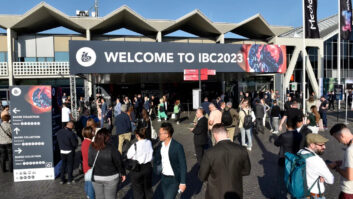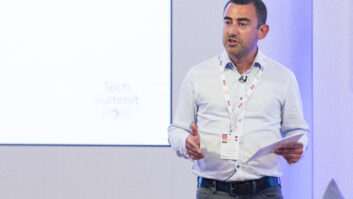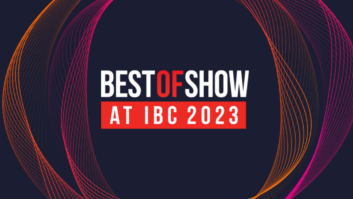
With the continued rise of smartphones, tablets and interactive TVs, the past ten years have seen a seismic shift in the way viewers consume content. Brightcove’s Luke Gaydon takes us through his predictions of the future trends and topics likely to be top of mind at this year’s IBC.
In less than 18 months, we could see the end of the UK public broadcaster, BBC, as its current Royal Charter is up for renewal in December 2016. When the existing charter was drawn up in 2006, the media landscape was very different BBC iPlayer was in Beta, Netflix’s core business was sending out DVDs in the post, and the on-demand services we now know and love were merely ideas on the back of a napkin.
Cut to the present day and the demand for online video has been a major contributor to the fivefold increase of internet usage around the world in the last five years. Cisco predicts that by 2019 over a million minutes of video will be viewed every second.
With this explosion in digital video consumption, traditional broadcasters must work out how to move with the times in order to keep all their audiences engaged whilst continuing to generate and grow revenue. So, what does tomorrow’s viewer want?
Thinking ahead to the 2015 IBC conference, here’s what we think will be the hot topics of discussion at this year’s show.
Channel 4’s All 4 approach is another great example of a traditional broadcaster moving to a ‘digital native’ model. It’s a traditional catch-up service, but adds original short form content and microsites to provide a unified experience. No more home channel website linking out to a separate on-demand service, the All 4 portal is Channel 4 one brand, one service, one user experience.
Stand-alone digital: Broadcasters moving more aggressively to offer online only services
Broadcasters would be wise to take lessons from native digital video content companies in order to maintain their audiences, and some of the big names are already doing this. For example, the BBC Trust’s decision to close BBC Three as a broadcast channel and move it online is partly proof of this new way of thinking.
One of the main factors in this decision was the way in which the BBC Three’s target audience, the 18-25 year old demographic, consume content. Stats showed they are increasingly watching TV online, demonstrated by the 250 million iPlayer requests recorded in July 2015, an 18 per cent increase over July 2014.
In order to remain relevant, broadcasters need the ability to adapt how they deliver content being able to develop the right content, in the right form and for the right viewers is key.
As a result, one single linear feed is no longer enough to engage audiences throughout the day. As consumers watch video on multiple devices at different times of the day, content must be developed across multiple feeds in order to capture their viewership and loyalty at all times. This all adds up to more work: editing clips for online use and publishing to and managing social media channels, so tools are needed to make these tasks more manageable.
Money, money, money: How to effectively monetise multi-screen digital services
Monetisation is obviously crucial for broadcasters, but once again, change is needed – the days of the traditional 30-second TV commercial are numbered. Progress has been made with native and interactive ads, but there is still a way to go. Driving this forward will be new technologies, along with powerful disruptors such as the rumoured updated TV product from Apple.

Ad blocking continues to be a growing concern for the industry, especially on desktops. The number of users employing ad blocking tools increased 41 per cent between 2013 and 2014, with 198 million active ad block users globally, according to figures from PageFair and Adobe.
As this number continues to increase, particularly among younger internet users, it will have a significant impact on advertising yield. PageFair and Adobe’s figures for 2015 estimate the total loss of revenue due to ad blocking software will be $21.8 billion.
This is where the benefits of server-side ad insertion come into play. By stitching the ads directly into the content, server-side ad insertion enables companies to not only deliver a seamless and consistent ad-supported video experience but also avoid client-side requirements that trigger ad blockers.
Moving from service to user experience
Broadcasters are increasingly focused on the whole viewer experience they know that a bad user experience across a particular device, app or platform can easily lose them viewers. As opposed to just providing a video feed to a distributor, they recognise that they need to be part of the entire end user experience ensuring their audiences have a complete, consistent, and appealing experience across every device and touch-point.
In addition, with audiences shifting away from appointment to view linear TV experiences, discoverability of content across different devices and services becomes critical to the goal of a seamless viewing experience. Content needs to be easily accessible and searchable regardless of channel, service or device. The same is true from the money to be made from content outside of the linear experience, if it isn’t easily discoverable then there is a risk of not making the optimum amount of ad revenue from that content.
What to watch out for in September
Despite all these developments in technology and business models, some things never change. Viewers are still looking for one thing above all: relevant high quality content that entertains or informs.
Netflix recently reported that its users spent 10 billion hours watching content in the first quarter of 2015, an average of more than 50 hours per user per month. The SVoD leader is known for excelling at a lot of user-facing details as well as its sophisticated content strategy and we expect the latter topic to also get frequent discussion at IBC. In particular, we anticipate less focus on the fight for broadcasting rights for live events, and more around the battle to secure quality on-demand content for ever-evolving consumer needs a conversation that will likely carry over to MIPCOM in October.
With all this said, IBC2015 is a snapshot in time and an early one in the evolution of these themes. When it comes to video online, marrying the best content with the best, monetisable experience will win and this has to be the goal for content providers planning for their futures at this year’s show.
4.B60






